

![]()
BORDER COLLIE COUSINS
EXTINCT WORKING COLLIES OF ENGLAND, IRELAND, AND WALES
EXTINCT TYPES IN WALES

Above, "The Grey Knight", Bob, Son of Battle,
from a 1904 version of the book published
by Doubleday, Page & Co., New York,
and photographically illustrated by A. Radclyffe Dugmore.
Bob was often considered a Welsh Grey,
until later publishers and ultimately Hollywood got hold of him.
Written into the Ancient Welsh Laws codified by Hywel Dda ca. 920 AD, is the herdsman's cur, regarded as, with a "bothy" and a knife, one of the three necessities for a herdsman's summer shieling.
At one time, Wales had many different types of shepherds' dogs. Much of Wales, because of its mountainous terrain, remained isolated and remote well into the 20th century, and Barbara Carpenter, in an article she wrote in 1994, was able to describe a few scattered remnants of these types that she remembered seeing in the 1970s and '80s.
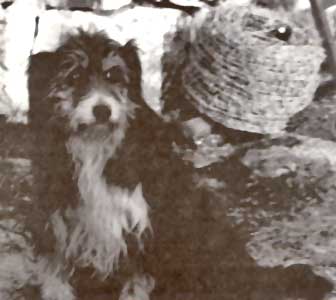 Left, a Welsh Grey sheepdog (photograph by Barbara Carpenter, taken at Rhandirmoyn, Wales, in 1987 or 1988)
Left, a Welsh Grey sheepdog (photograph by Barbara Carpenter, taken at Rhandirmoyn, Wales, in 1987 or 1988)
THE WELSH GREY
On the Welsh Grey, Barbara Carpenter (The Shepherd's Dogge, Fall 1994) said:
The ubiquitous Border Collie has gradually supplanted the many ancient types of herding dogs indigenous to various areas of Britain. [Those] Welsh breeds are now extinct, except for perhaps a few Welsh Grey Sheepdogs, which I saw several years ago, working cattle on a hill farm. These shaggy dogs, similar to the working Bearded Collie, have been bred pure in that district. One line is said to breed stumpy tailed dogs. So, perhaps this old breed might just about survive a while longer.
Mrs. Carpenter thought some Welsh Greys might still have existed in some isolated pockets of Wales, but sadly, today the type is considered extinct.
"Owd Bob, The Grey Knight", top, from the novel Bob, Son of Battle (first published by Doubleday, Page & Co., 1898) is thought to have been a Welsh Grey. Here is how Alfred Ollivant described him:
A rare dark gray he was, his long coat, dashed here and there with lighter touches, like a stormy sea moonlit. Upon his chest an escutcheon of purest white, and the dome of his head showered, as it were, with a sprinkling of snow. Perfectly compact, utterly lithe, inimitably graceful with his airy-fairy action; a gentleman every inch, you could not help but state at him--Owd Bob o'Kenmuir...small, yet big; light to get about on backs o' his sheep, yet not too light. Wi' a coat hard a-top to keep oot Daleland weather, soft as sealskin beneath...the Gray Dogs o' Kenmuir!
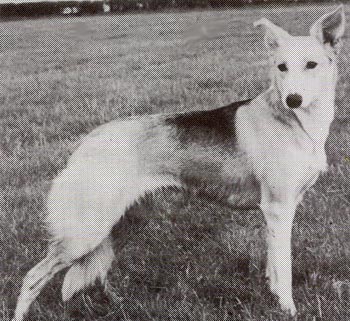 Right, a Welsh Hillman (photo taken by Barbara Carpenter in 1976)
Right, a Welsh Hillman (photo taken by Barbara Carpenter in 1976)
THE WELSH HILLMAN
Barbara Carpenter also believed she had seen the last known Welsh Hillman, a dog that David Hancock called "a fine-looking red-coated dog". Mrs. Carpenter described the Hillman as "a tall dog, similar to the present-day smooth-coated hill dogs sometimes seen in the English Lake District. They were usually light sandy-coloured, with a black saddle, white chest, white on legs and tail, and a blaze on face. They were prick-eared and of smart, upstanding stance. Blue merle dogs were also bred." The dog she knew was " 'Jess', purchased from a hill farm in the Hay-on-Wye area in 1974. She was a companion dog, and had unfortunately been spayed before her owner realized her rarity. Jess died in 1990, so this ancient breed is no more."
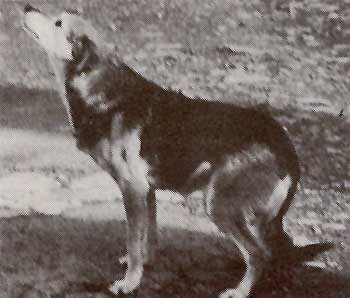 Left, a Welsh Black-and-Tan sheepdog (photo taken by Barbara Carpenter in 1987)
Left, a Welsh Black-and-Tan sheepdog (photo taken by Barbara Carpenter in 1987)
THE WELSH BLACK-AND-TAN
The Welsh Black-and-Tan is another pastoral type that is thought to be extinct. Barbara Carpenter described it as "a smaller dog [than the Hillman], smooth-coated, and black-and-tan, as its name suggests." She said that it was "thought to be extinct, but to my amazement in 1987, I saw 'Tan' in a Welsh hill farmyard, and was assured that she was a purebred Blank-and-Tan, the last of the breed. Not being able to find a dog of this breed, she had been mated a few years previously to a Huntaway." We are very lucky indeed that Mrs. Carpenter saw fit to take pictures of both Jess and Tan and record these breeds or types for posterity.
Both the Welsh Hillman and the Welsh Black & Tan were descended from the ancient herding and hunting dogs of Wales. The 10th century Laws of Hywel Dda (Howell the Good) gave the work of an efficient herding dog as that of an ox in its prime.
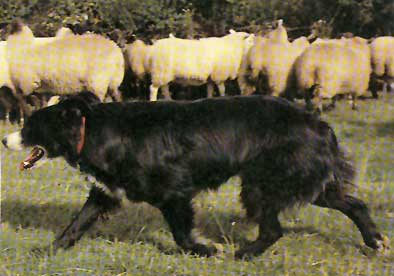 Left, a bob-tailed sheepdog photographed on the border between England and Wales (detail of a photo by Chris Gregory from The Field, December 1987)
Left, a bob-tailed sheepdog photographed on the border between England and Wales (detail of a photo by Chris Gregory from The Field, December 1987)
THE BOB-TAILED WELSH SHEEPDOG
In 1987, David Hancock, author of Old Farm Dogs (1999 by Shire Publications, Ltd.) and Old Working Dogs (1984 by Shire Publications, Ltd.), wrote an article entitled "Bob-tailed survivors in the cur-dog tradition" (The Field, December 1987), Hancock wrote about a type of collie that he found in the border region between the Welsh county of Gwent and the English county of Herefordshire.
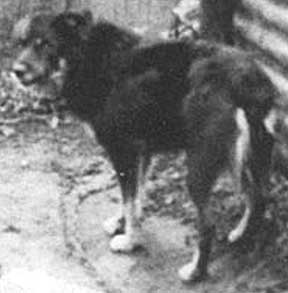 Left, a Welsh Bob-Tail (photo by David Hancock from "Bob-tailed survivors in the cur-dog tradition", The Field, December 1987.)
Left, a Welsh Bob-Tail (photo by David Hancock from "Bob-tailed survivors in the cur-dog tradition", The Field, December 1987.)
He describes these dogs as looking much like the Border Collie, but tail-less, with a harsher temperament and working in a dissimilar way. Of their lack of a tail, Hancock says, "This is initiated genetically, not as a result of veterinary amputation...When a tail-less or short-tailed breed is crossed with a breed of full-length tail, the short-tailed type is dominant..."
He also says "Their appearance is reminiscent of the old crossbred drovers' dogs and cur-dogs depicted and described more than a hundred years ago. Like them, these bob-tailed dogs are alert, aggressive, fiercely protective and suspicious of strangers." He implies that these dogs are actual descendents of drovers' dogs from the 19th and early 20th century.
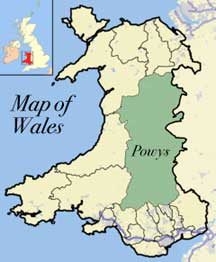
The country where these dogs were found is described by Hancock as "sheep and cattle country not far from Offa's Dyke [that once separated the Welsh county of Powys from the then Kingdom of Mercia, today the English Midlands], hilly, rocky, bleak in winter and a tough test for any herding breed." A tougher dog than the Border Collie is needed in countryside like this and thus a tougher dog is being perpetuated, " says Hancock, "in an isolated area where dogs have long been valued for their work rather than their conformation to a breed standard." He tells us that this type of sheepdog "will always be too fierce for household pets and they are too sharp for many farmers. But they represent the cur-dogs of long ago and are worth conserving."
But...is this type really extinct?
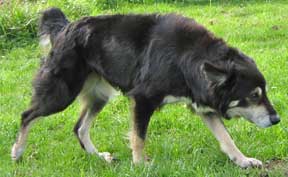
Above and below left and right, Rebecca Lewis' bobtailed sheepdog, Taff.
In the one above, you can see her tail. She has a tail, only it is "bobbed".
TAFF, A BOB-TAILED WELSH SHEEPDOG
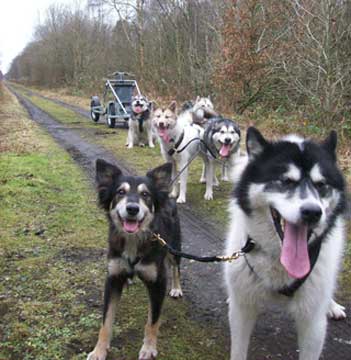
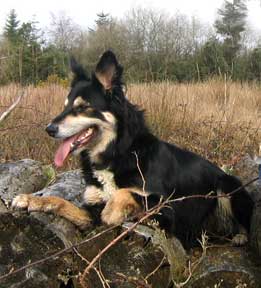 In 2009 I heard from Rebecca Lewis, who lives near Ellesmere in Shropshire, close to the Welsh Border who wrote:
In 2009 I heard from Rebecca Lewis, who lives near Ellesmere in Shropshire, close to the Welsh Border who wrote:
I can confirm without any doubt that it is not [extinct]! There is one [sitting] in front of me - Taff. My husband, Dai, grew up on a hill farm in Ystradfellte (Powys) and bobtail collies are still in fair numbers there and around Sennybridge. They are preferred by the hill farmers there for moving much larger numbers of sheep than the Border Collie. She is a tough dog, when bringing in dairy cows on a dairy farm where I used to work she decided the bull was not going fast enough. He kicked her clean across the track and through the fence after she bit him, she rolled over and got straight back up to batter him!
...[S]he is fiercely protective and suspicious of strangers - not a fan of the postman!! But very soft with those she knows. This bitch is now 10 years old...Taff started life herding sheep then went with my husband to a dairy farm where she continued working. She is now retired from pastoral work as my husband is a cattle AI man, but being a non-conformist she continues to work - in harness with the Eskimo dogs...we also keep Canadian Eskimo Dogs.
...[T]he bob is natural. They are black and tan in colour.
That this type of sheepdog is a versatile worker is illustrated by the fact that Taff can work in harness with the huskies that Rebecca and Dai Lewis also raise. Taff has her own web page on the Lewises website, Steelpaw Sled Dogs.
For more information on Welsh Bobtails, see the following article:
The Old Welsh Bob Tail Connection
It tries to make a connection between the Australian Shepherd and the Old Welsh Bobtail. There may indeed be one, but without genetic testing we will probably never know. Even with genetic testing, all the current collie breeds may be so closely related that to single out two of them and make some special connection between only those two may be impossible.
EXTINCT TYPES IN ENGLAND
[Unfortunately, we have been unable to find any photos or even drawings of the extinct English dogs, so if anyone out there has one or knows where we can find one, please contact me at carole@woolgather.org. You will be given full credit.]
THE "GOAT-HAIRED" SHEEPDOGS
Bearded dogs like the Old English Sheepdog and the Bearded Collie, breeds covered in seperate pages in the Border Collie Museum, have probably existed in the British Isles for centuries, without actually having been named. In old photos it is sometimes difficult to distinguish among the various strains of shaggy-coated sheepdogs, the biggest differences being perhaps lack of a tail, length of coat, or length of the body (the distance between the front legs and the back legs). David Hancock also pointed out the resemblance between the OES and the Bearded Collie and several other breeds or types that are now extinct, like the Sussex Sheepdog and the Welsh Grey, above. Many shepherds by the middle of the 19th century, had both a bearded-type and a Border Collie-type dog, mainly because they worked differently and were therefore used for different types of work. Hancock called the bearded ones "goat-haired sheepdogs" and he said they "illustrate how coat length and texture, size and working style developed out of the farmer's needs."
Despite the fact that National Geographic said in 1919, "[The OES] has long been used as a practical helper in the great sheep ranges of western Canada"[10], it would not be inappropriate, I think, to say that the OES as a working dog is probably extinct today, very much like its other shaggy cousins, the Dorset Blue Shag, the Sussex Sheepdog, the Smithfield (extinct in Britain, but very much alive in Australia), and other local varieties.
OTHER EXTINCT TYPES
There are a number of other collie breeds in Great Britain that have gone extinct, their names but alluded to in books. Others that come to mind are the Cumberland, the Dalesman, the Manx, and the Warwickshire. Information on them is seriously lacking. In the future, I hope to be able to find out more about them, and if anyone has information on these extinct breeds (or knows that they are not actually extinct) I would very much appreciate hearing from you; but for now, I'll make reference to only two: the Cumberland Sheepdog and the Manx
The Cumberland Sheepdog was mentioned by Clifford Hubbard in 1948. He described it as a "breed...much like the Welsh Sheepdog and the old working Collie types, [that] works quietly, quickly and low-to-ground", similarly to the Border Collie. There is no mention of "eye". The physical description does not appear to make it very different from the Border Collie either, being black-and-white, medium build, rough-coated, and with a low-set tail carried low.
Its history is tied to Lord Lonsdale, whose family owned Cumberland Sheepdogs for more than a hundred years. Hubbard said that "Cumberland farmers have entered this breed in Sheepdog Trials for at least sixty-five years, [and] indeed, many of the so-called Border Collies which have won awards have really been Cumberland Sheepdogs." Since they looked and worked like a Border Collie the point is moot. The Cumberland Sheepdogs were likely just a local variant of the same dog. Even today, unregistered sheepdogs do not get to use the name Border Collie.
The Isle of Man is in the Irish Sea between England and Ireland and is a self-governing Crown dependency; so the Old Manx Sheepdog isn't precicely an extinct English breed, but I have grouped it here for want of somewhere else to put it. The Manx, or Old Manx Sheepdog, was described by Adelaide L. J. Gosset in 1911. She wrote "Shepherd Caley of Ramsey tells us that the old Manx sheep-dog was a 'holding', not a driving dog. It kept to heel, and when a particular sheep was wanted, the shepherd would point to it and say in Manx, 'There, Spring, go and hold that rough fellow', and the dog would seize the sheep behind the neck, throw it down, and hold it with his paws, never hurting it. These dogs are now extinct in the island..."
Gosset goes on to say that this dog was smooth-coated, came in a variety of colors, and was very big and strong. Some, she said, were tan mixed with grey to produce a rust color, which sounds suspiciously like brindle. They were called "houl'ers" because they howled.
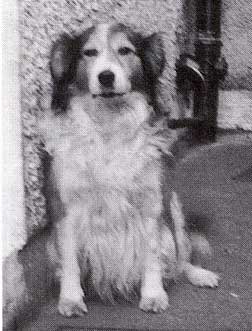
Above, an old fashioned Irish collie. (Photo courtesy of Marjorie Quarton.)
EXTINCT TYPES IN IRELAND
In the 1980s I visited the Isle of Arran in the Firth of Clyde, and while there attended a sheepdog trial. I noticed that all the competing dogs were smooth-coated, and stopped to speak with one of the trialists. He told me that the farmers and shepherds in Arran preferred smooth-coated dogs. It was a reminder that in most parts of Great Britain and Ireland there had been local collie types that persisted even into the 20th century. Much of the British Isles was remote, and local preferences prevailed. Arran in the 1980s was still somewhat remote, and though all the dogs were registered Border Collies, they were of one particular physical type. Today, the Border Collie has replaced many if not all of these local types throughout the British Isles, and the local types have become virtually extinct. No place is it more apparent than in Ireland.
Marjorie Quarton wrote "Border Collies came into Ireland first from Scotland into Ulster, then from Wales into Leinster. Many English landlords with estates [in Ireland] employed Scottish or Welsh shepherds who brought their own dogs with them. The dogs proved themselves to be faster and more biddable than the native dogs..." As cattle were always more important than sheep in parts of Ireland, the local dogs were larger and built more heavily, with heavy sable coats. These dogs "worked both the head and heel of cattle, biting seldom, but barking incessantly...For sheep, they were too slow, had no 'eye' and worked too close..." This was the type of dog that Quarton remembers while growing up in Tipperary in the mid-west of Ireland. She does not give it a name, as it was just a local type.
Galway, on the west coast of Ireland was sheep country, and a different type of dog existed there. The Galway Collie was a lighter, shorter-coated, black-and-white or tricolored dog. Quarton also describes a dog similar to the Welsh Hillman to manage large flocks of sheep on the hills. Two other types in Ireland were the Glenwherry Collie from Antrim which David Hancock called "marbled" (i.e., merled) and the Wicklow Collie. Very little information is available on these dogs today. There are likely to have been even more named types.
Iris Combe implied an ancient origin for the Irish collies, tracing them back to Celtic and Viking dogs; but, as our Collie Family Tree, above, indicates, while dogs brought by waves of conquerors and settlers likely contributed to the gene pool of these pastoral types, native local dogs were more than likely already in place when the incomers arrived and were crossbred with them for traits that were desired. So, while local varieties were able to withstand the onslaught of foreign dogs and still survive, very few native types have withstood the phenomenon of the Border Collie, particularly in Ireland.
Copyright © 2013 by Carole L. Presberg
Return to
![]()
BORDER COLLIE COUSINS
THE OTHER WEB PAGES WE MAINTAIN
These web pages are copyright ©2013
and maintained by webmeistress Carole Presberg
with technical help from webwizard David Presberg
ALL RIGHTS RESERVED
If you are interested in using ANY material on this website, you MUST first ask for permission.